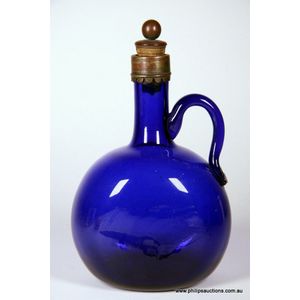Minton Pilgrim Vase with Pate Sur Pate Decoration
You must be a subscriber, and be logged in to view price and dealer details.
Subscribe Now to view actual auction price for this item
When you subscribe, you have the option of setting the currency in which to display prices to $Au, $US, $NZ or Stg.
- Pâte-Sur-Pâte - Pâte-sur-pâte is a decorative technique that is commonly used in ceramics and glassmaking. The term "pâte-sur-pâte" is French and it translates to "paste on paste." This technique involves the application of layers of clay or glass paste to create a three-dimensional design.
In ceramics, the technique involves applying successive layers of a clay slip onto a piece of pottery. Each layer is allowed to dry before the next one is applied. The layers are then carved or incised to create a design in relief. This technique is often used to create delicate and intricate designs, such as figures or floral motifs.
In glassmaking, the technique involves applying layers of molten glass onto a blown glass form. The layers are then carved or etched to create a design in relief. This technique is often used to create intricate designs, such as floral motifs or animals.
Both techniques require a high level of skill and precision, as the layers must be applied and carved with great care to achieve the desired effect. The end result is a beautiful and unique piece of art that showcases the artist's talent and mastery of their craft. - Oak - Native to Europe and England, oak has been used for joinery, furniture and building since the beginning of the medieval civilisation. It is a pale yellow in colour when freshly cut and darkens with age to a mid brown colour.
Oak as a furniture timber was superceded by walnut in the 17th century, and in the 18th century by mahogany,
Semi-fossilised bog oak is black in colour, and is found in peat bogs where the trees have fallen and been preserved from decay by the bog. It is used for jewellery and small carved trinkets.
Pollard oak is taken from an oak that has been regularly pollarded, that is the upper branches have been removed at the top of the trunk, result that new branches would appear, and over time the top would become ball-like. . When harvested and sawn, the timber displays a continuous surface of knotty circles. The timber was scarce and expensive and was used in more expensive pieces of furniture in the Regency and Victorian periods. - Attributed - A cataloguing term where the item in the opinion of the cataloguers, is a of the period of the artist, craftsman or designer, and which probably in whole or part is the work of that person.
- Cartouche - An ornamental panel in the form of of a shield, oval or rectangular scroll with curling edges. It may be carved into the back of a chair or the top of a sideboard, or present on a piece of silver or jewellery, and contain the initials of the original owner, heraldic symbols, or some other inscription, such as the details of a presentation.
In ceramics the term defines the central area of a vase or similar with a decorative border in one of the shapes above, into which a decorative scene or figures have been painted. - Circa - A Latin term meaning 'about', often used in the antique trade to give an approximate date for the piece, usually considered to be five years on either side of the circa year. Thus, circa 1900 means the piece was made about 1900, probably between 1895 and 1905. The expression is sometimes abbreviated to c.1900.
This item has been included into following indexes:
Visually similar items

An antique Pique purse by Brevete, the round tortoise shell purse with applied gold detail and engraved initials Ebg, having a blue moire taffeta interior with separate coin compartments, with a fine gold belcher chain attachment. Condition: overall condit

1930's Umpires Eight Ball Cricket Counter with 'Lyrebird' on face

A Victorian Bristol blue glass Flagon decanter, 19th century, of compressed ovoid form with a slender neck and an applied handle, with brass mounts and the original brass and cork stopper. Height 22 cm

Pair of South Sea pearl, emerald, sapphire and diamond pendant earrings, Paspaley, each terminating in a round cultured pearl swing drop measuring approximately 13.00 mm suspended from a half hoop channel-set with a double row of brilliant-cut diamonds sur
